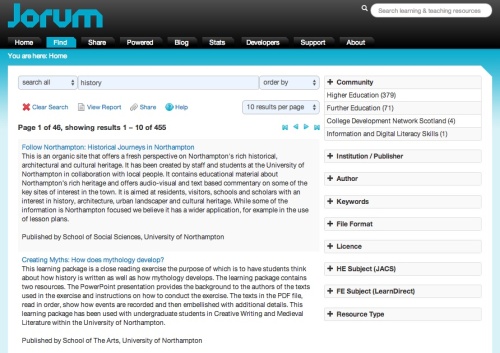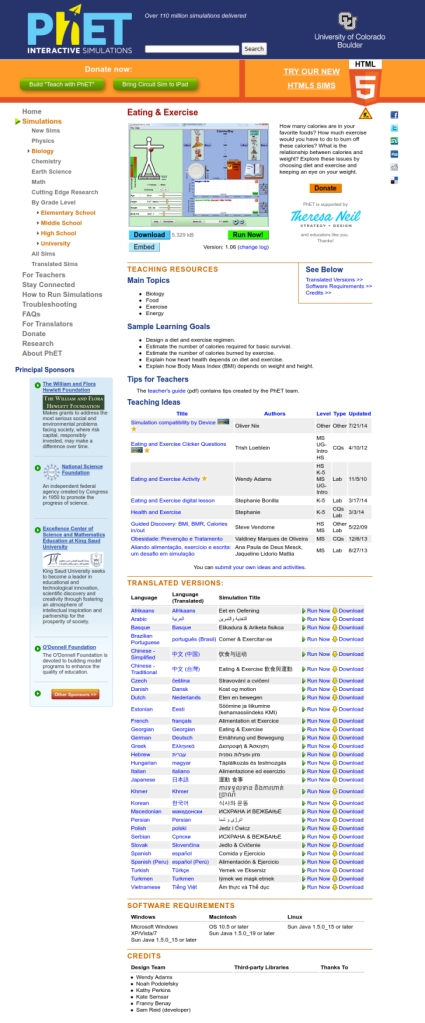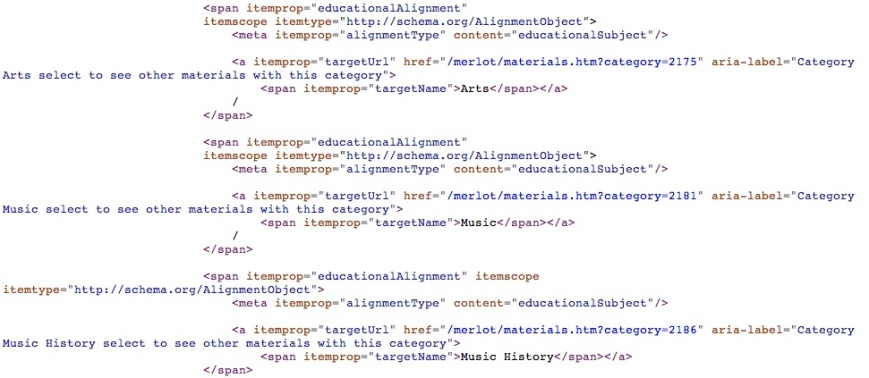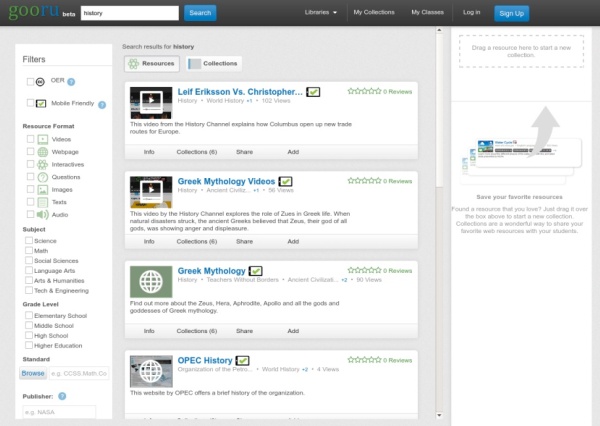ISKME’s OER Commons offers a comprehensive infrastructure and suite of services for educators globally, including groups of curriculum specialists, administrators, content providers, teachers, librarians, and technology and resource decision-makers who seek to implement high quality and adaptable curriculum through the use, evaluation, and improvement of open educational resources (OER).
Launched in 2007, OER Commons serves as a digital library and collaboration platform for content providers and emerging open education practitioners at all levels. Engaging with over 500 OER content providers from around the world, ISKME provides the open scaffolding necessary for knowledge sharing and access to teaching and learning materials, strategies, and curricula online. The site has over 35,000 registered users, 55,000 resources, and millions of visitors from 193 countries.
Author Archives: Lorna Campbell
LRMI Implementation Case Study: OpenStax CNX
Project lead: Daniel Williamson, CNX
“OpenStax believes that everyone has something to learn, and everyone has something to teach. OpenStax CNX is a dynamic non-profit digital ecosystem serving millions of users per month in the delivery of educational content to improve learning outcomes. There are tens of thousands of learning objects, called pages, that are organized into thousands of textbook-style books in a host of disciplines, all easily accessible online and downloadable to almost any device, anywhere, anytime.”
OERde14 – The view from Scotland
[Cross posted to Open Scotland]
I’m delighted to have been invited to Berlin later this week to give a talk at OERde14 – The Future of Free Educational Materials. I’ll be talking about a range of contrasting initiatives that have aimed to promote open education policy and practice in Scotland, England and Wales over the last five years, including the UKOER Programme, Open Scotland, OER Wales, the Welsh Open Education Declaration of Intent, the Scottish Open Education Declaration and the Opening Educational Practice in Scotland project. I’ll also be reflecting on the different approaches taken by these initiatives and asking what Germany can learn from the experiences of open education practitioners in the UK.
LRMI Implementation Cases Study: Untrikiwiki
“The purpose of this project was to allow MediaWiki-based Open Educational Resource (OER) communities to adopt LRMI. This was done in two ways. Firstly, we built the technical infrastructure necessary for MediaWiki-based OER communities to implement LRMI. Secondly, we approached MediaWiki-based OER communities in attempt to convince them to use LRMI.”
LRMI Implementation Case Study: Curriki
Project team – Joshua Marks, Chief Technology Advisor, Robert Greenawalt, Chief Technology Officer, Paul Libbrecht, Developer.
“Curriki provides peer reviewed open educational resources, curricula and instructional materials to support teachers, professional educators, students, lifelong learners, and parents, primarily in the domain of K-12 education. Curriki is a nonprofit organization and the majority of the resources it provides carry Creative Commons licenses.”
LRMI Implementation Case Study: P2PU
“P2PU is a grassroots open education project that organizes learning outside of institutional walls and gives learners recognition for their achievements. P2PU creates a model for lifelong learning alongside traditional formal higher education. Leveraging the internet and educational materials openly available online, P2PU enables high-quality low-cost education opportunities. Learning for the people, by the people. About almost anything.”
LRMI Implementation Case Study: PhET Interactive Simulations
Project Team – Kathy Perkins, Director and Jonathan B Olson, Software Engineer
“PhET provides fun, interactive, research-based simulations of physical phenomena for free. We believe that our research-based approach- incorporating findings from prior research and our own testing- enables students to make connections between real-life phenomena and the underlying science, deepening their understanding and appreciation of the physical world.”
The PhET LRMI implementation project ran from July 2012 – July 2013. PhET currently has 128 simulations which are used over 45 million times per year. Since the site has 36 current website translations, unique metadata is provided on 4608 pages (each translated page has LRMI metadata in that language). The simulations are aimed primarily at K-12 and college use, but are designed to be compatible with any type of education. All simulations are licensed under the GPL, and most are also licensed CC BY.
LRMI is integrated into PhET metadata, so it is detectable by third parties that crawl or search the website. The site also provides Dublin Core, NSDL Dublin Core, IEEE LOM, IMS LODE ILOX, and a custom super-set of this metadata available via OAI-PMH and a REST API. Additionally, various custom exports have been created, usually CSV-based and customized to a particular portal. Metadata is stored in the PhET website’s main database and metadata for third-parties is automatically generated from the database, on demand, in a variety of formats. Since metadata is provided only for simulations, PhET does not store many of the LRMI properties internally in the DB since they are the same for every simulation. However the mapping includes translations (viewing a page on the Korean translation of the website will include Korean terms in the metadata).
PhET has implented the following LRMI properties and types:
- educationalAlignment: yes, includes multiple standards alignments
- educationalUse: yes, “classroom”, “homework” and “solution” for simulations
- interactivityType: yes, “active”
- learningResourceType: yes, “simulation”
- useRightsUrl: yes, can include multiple URLs (many simulations are dual-licensed)
PhET has not implemented:
- timeRequired: no (for inquiry-based simulations, there is no “standard” time required)
- typicalAgeRange: not yet, had previous uncertainty about format
- isBasedonUrl: no, simulations are original works
Currently “educationalAlignment” aligns to the Math Common Core, but the project team is currently working with teachers to create an NGSS alignment, which can be added.
PhET also implements the Schema.org “SoftwareApplication” type which enables them to provide available language information, denote PhET as the publishing and authoring organization, provide thumbnail and screenshot image URLs, denote it as applicationCategory:Educational, provide the “run now” and “download” URLs (url and downloadUrl), the download filesize, version/softwareVersion, description (in the language provided), a list of keywords, and dates created / modified.
During the funded phase of their LRMI implementation project, PhET initially shared their metadata with the Learning Registry, but as the Learning Registry has changed their protocols so frequently the project team has not been able to keep up with their change requests. PhET is currently not listed as Learning Registry contributors, but the team hopes that they will be able start sharing their metadata again once the protocols have settled down.
PhET has no current plans to develop their LRMI implementation further, unless there is additional demand from other organizations. The project team is unsure of how to measure the direct benefits of LRMI implementation but they are pleased that their simulations include LRMI metadata. Other third-party projects have also been pleased that PhET make LRMI metadata available and have pulled that data into their own applications.
LRMI Implementation Case Study: MERLOT
Team leader: Barbra Beid Sperling
“MERLOT is a free and open peer reviewed collection of online teaching and learning materials and faculty-developed services contributed and used by an international education community. The MERLOT collection consists of tens of thousands of discipline-specific learning materials, learning exercises, and Content Builder web pages, together with associated comments, and personal collections, all intended to enhance the teaching and learning experience.”
MERLOT is a metadata repository containing records for 46,000 open educational resources covering a wide range of subjects and all levels of education. Users are able to comment on and aggregate resources to create personal collections. MERLOT resources are peer reviewed by members and each resource record includes a “Quality Box”, which presents information on peer reviews, user ratings, comments and collections the resource has been added to.
MERLOT also provides access to a wide range of additional facilities including APIs to integrate with learning management systems and other applications, mobile search apps for iOS, Android and Blackberry, a content builder for creating hosted online learning materials and various community building tools such as discipline communities, community discussions, and social networking facilities.
MERLOT uses Spring Framework as well as a number of Apache Commons java libraries and is served from CentOS (Linux) using Apache and Tomcat. Eclipse IDE, Vim and Notepad++ are used for editing, and Mozilla Firefox for testing. MERLOT applications are not open source.
MERLOT has developed a proprietary metadata schema, which covers a range of common fields including title, URL, description, material type, primary audience, language, keywords, subject category / disciplines, author information, technical format, technical requirements, mobile platforms, license, cost and accessibility. Fields are stored in Oracle database tables. Metadata is created by users when a resource is added to MERLOT, and it is rarely modified beyond this point, other than to verify that all links still work. MERLOT does not share metadata with the Learning Registry, and MERLOT metadata records are not Creative Commons licensed.
A mapping (.xls) has been created between the proprietary MERLOT metadata schema and LRMI to enable the appropriate microtags to be added to resource description pages within MERLOT.
Merlot uses the following LRMI properties:
- educationAlignment
- useRightsUrl
Plus additional Schema.org properties:
- creativeWork,
- headline,
- rating,
- aggregateRating,
- offer
The alignmentType of educationAlignment is educationalSubject, which maps to a proprietary vocabulary.
Since implementing LRMI MERLOT has not observed any measurable impact, although it is possible that the presence of LRMI and schema.org metadata on MERLOT’s resource description pages increases the discoverability of resources.
Links
MERLOT
MERLOT / LRMI mapping (.xls)
LRMI Implementation Case Study: Gooru
Project lead: Lisa McLaughlin, Senior Director of Partnerships
“Gooru’s mission is to honor the human right to education. We are dedicated to engaging a community of teachers, developers, and supporters to unleash personalized learning with technology to educate all the students of the world.”
Gooru serves as a personalized learning platform, incorporating a custom search engine, playlist creation tool, and content aggregator. The system allows users to find standards-aligned, interactive learning materials that have been curated by teachers; share those materials in the form of custom collections, personalized to meet the needs of individual students; and measure students’ progress across collections and quizzes assigned to them. Users can search over 2 million CC licensed learning resources, browse through collections, lessons and individual resources and filter search results by grade level, resource type, and Common Core State Standard.
Gooru is a repository of playlists, rather than a repository of content. There are currently 18 million resources in the Gooru catalog; 180,000 of these are tagged to instructional standards such as the Common Core State Standards and 50,000 are collections created by teachers and students. Users can also build assessment features into their playlists and the system includes an assessment bank of 1.5 million items. Gooru resources carry a variety of different licences but all are open and free to use. Playlists are currently shared under a CC BY SA licence, however Gooru are in the process of transitioning to CC0 over the course of the next month. Most content is aimed at the K-12 sector.
Gooru has developed an open source learning architecture licensed under the MIT Open Source Initiative approved licence, and a number of APIs that enable developers to build applications based on the Gooru infrastructure. The Gooru APIs are available here: Gooru APIs, and further information about the Gooru development community is available here Gooru Learning Developers.
A custom Gooru Metadata Schema (GMS) composed of 40 fields has been created from various metadata schemas. The Gooru Metadata Schema may be regarded as a variant of the LOM, though to date, GMS has not been mapped directly to LOM. Accessibility Metadata Project fields are used to describe the accessibility of content.
Content with high quality metadata is weighted more heavily in search results, though other factors also come into play, such as how many times a resource is included in other playlists.
Gooru does not ingest metadata through OAI PMH; some metadata is generated by users uploading resources and tagging them using the GMS, but the majority comes from web crawling. Domains are curated through a range of input, both internal and through Gooru’s wider network of partners, before pursuing crawls. Teacher-added domains are prioritized. Basic metadata including title, author, publisher, description, etc is captured from each domain, and then passed to a QA cleaning team, who manually identify more nuanced characteristics, e.g. educational use, time required, etc. For subjective fields, such as educational use, a script has been created for cleaning the metadata. The QA team is currently focused on cleaning the metadata on all OER collections and Gooru recently launched an OER filter.
Metadata fields are currently stored in an SQL database, however Gooru will move to a no-SQL framework later in 2014. Paradata is also stored in similar SQL tables but is returned by different APIs. Only some of the Gooru paradata is currently exposed.
Components of LRMI have been incorporated into the Gooru Metadata Schema and a mapping can be provided from the GMS to LRMI. Approximately 95% of the Gooru catalog is now tagged with LRMI.
The following LRMI properties and types have been implemented and the Gooru LRMI Metadata schema is available here (.xls).
- educationalAlignment
- educationalUse
- timeRequired
- typicalAgeRange
- interactivityType
- learningResourceType
- useRightsUrl
- isBasedonUrl
The GMS includes an Educational Alignment field with alignment types ‘subject’ and ‘educational level’. Alignment type ‘text complexity’ may be added in the future.
In addition to Common Core State Standards, Gooru content is also aligned to Texas Curriculum Standards and California Science Standards
Links
Gooru
Gooru Metadata Guide
Gooru LRMI Metadata Schema
LRMI Implementation Case Study: Jorum
Project lead – Ben Ryan, Jorum Technical Coordinator.
“Jorum is a Jisc funded Service for UK Further and Higher Education, to collect and share open educational resources, allowing their reuse and repurposing. Jorum’s free online repository service forms a key part of Jisc’s Learning and Teaching digital content offering. It is the first port of call for thousands of resources, all shared and created by those who teach or have been inspired in the FE and HE and professional skills community.”
The Jorum LRMI implementation project began in September 2013 and work is ongoing as the platform develops. Jorum is a DSpace repository containing a wide range of educational resources in many different formats, including a considerable volume of IMS Content Packages. The repository contains approximately 16,000+ resources, most of which are openly licensed. Jorum uses a combination of LOM, DC, LRMI, Jorum metadata, plus custom fields for different collection ‘windows’. LRMI properties are crosswalked to LOM education fields.

Jorum search returns page
Implementing LRMI in Jorum presented something of a challenge to the project team as DSpace only allows metadata to be added to ‘items’ which are collections of individual files. Metadata can not be applied at the file level, e.g. an html page within a content package, and there is no way to add microdata to an individual page. If Jorum ingests a resource that already includes LRMI it can be cross walked to map to the LOM fields, however if a content package contains multiple pages that are marked up with LRMI it is difficult to extract this data as there is nowhere to store it in DSpace. In addition, in order to enable a search engine to access a full set of LRMI metadata it is necessary to generate a page containing the LRMI which the search engine can hit. The default page generated by DSpace only includes title, author and description. To generate a page with a richer set of metadata it is necessary to create a custom theme, which is a non trivial task.
Jorum resource page
Despite the technical difficulty of implementing LRMI in DSpace, the Jorum project has made good progress and the team have plans for further development in this area including implementing the new Schema.org License property, implementing the alignmentObject and aligning it to the UK higher education Joint Academic Subject Coding Scheme. The project team also plan to build a Google Custom Search engine to demonstrate how Jorum LRMI metadata can be surfaced.
Jorum has implemented the following LRMI properties and types, though this is dependent on what metadata has been supplied for each resource.
- educationalAlignment: plan to implement in the future
- educationalUse: yes,
- timeRequired: yes
- typicalAgeRange: no
- interactivityType: yes
- learningResourceType: yes
- useRightsUrl: no, but plan to implement License property
The Jorum project team have not yet shared their LRMI metadata with the Learning Registry as they are waiting to upgrade their platform to DSpace 4.0 before taking this implementation forward as DSpace 4.0 includes an upgraded OAI PMH interface providing a good flexible way to generate metadata from different schema. It should be noted that Jorum have already undertaken a successful Learning Registry implementation project, the Jisc funded JLeRN Experiment ( which successfully built a Learning Registry node in the UK and developed a number of prototype services for LR ingest and querying. The same developer responsible for the JLeRN implementation has been commissioned to undertake the Jorum LRMI implementation and this work will be taken forward once the upgrade to DSpace 4.0 is complete.
Links
Jorum
Jorum Case Study Questionnaire
Jorum Blog: Implementing the Learning Resource Metadata Initiative (LRMI) in Jorum






